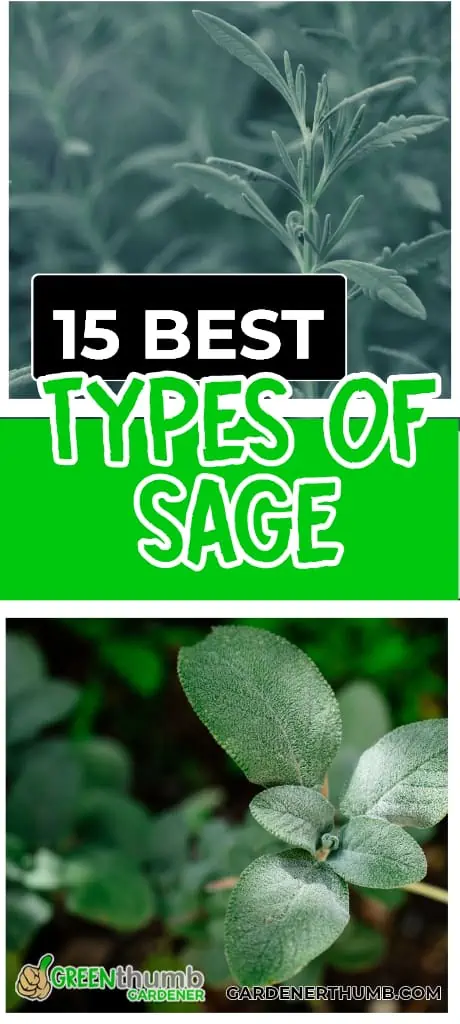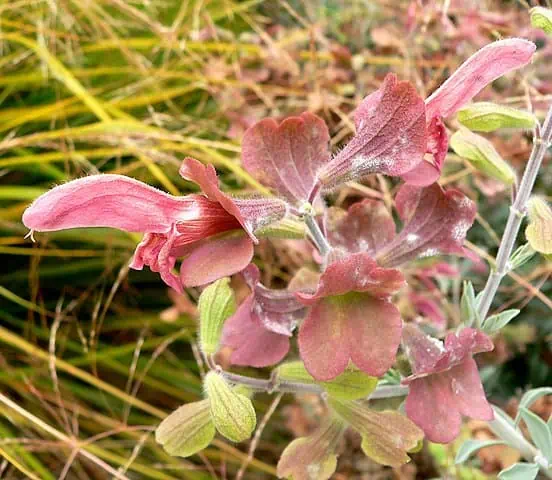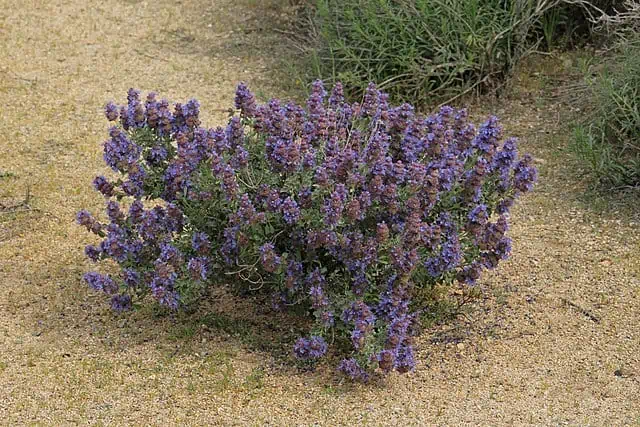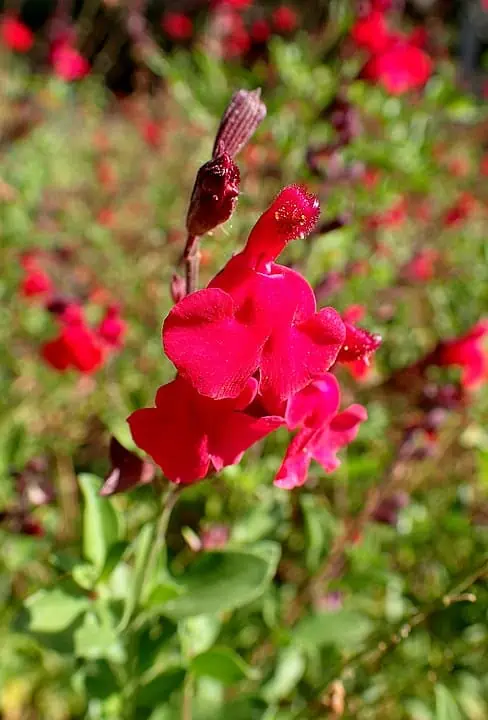Types Of Sage You May Not Have Heard Of
Last updated: 03/16/22
Sage is an excellent plant to grow since it is easy to maintain. It is more than just a plant with pretty purple flowers; it serves a purpose as a fresh or dried herb.
This perennial shrub is popular among gardeners because of its resistance to pests and diseases, compact size, and forgiving nature.
Maybe you heard of smudging?
Sage also have medicinal & ceremonial properties and have been used in traditional medicines by tribal people.
While strolling through your local garden, you will almost certainly come across an almost infinite variety of sage plants and blooms.
In addition, a variety of sage products will be available for purchase at your local grocery store when you go shop.
So, what exactly are sage plants, and how do we cultivate them?
Green thumb Gardener occasionally links to product and/or services offered by vendors to assist you with all your gardening needs. Some of these may be affiliate links, meaning we earn a small commission if items are purchased.
Want to Download a Garden Hack Guide for FREE

Enter your email below and we will send you a guide to help you SAVE money in your garden.
What Is Sage?
Among the Lamiaceae family, Salvia is the largest genus. Sage is a common ingredient in a wide range of cuisines across the globe.
Salvia or sage is a mint-like herb that smells mint and looks similar to lavender as part of the mint family.
The sweet-scented sage or salvia plants can be found in various shapes, sizes, and colors, depending on the kind.
This lovely plant has foliage available in several hues, ranging from lavender to brilliant blue to lively red. In addition, its blooms are available in various colors, ranging from vivid blue, lavender, and vibrant red.
It can be used either for culinary purposes or as an ornamental plant. Small amounts of sage are often utilized because of its aromatic leaves and earthy flavor.
It has a lot of antioxidants, and sage extract can enhance cognitive performance, help maintain good oral health, and lower cholesterol and blood sugar levels.
They can be either a perennial or annual plant, flowering or non-blooming, but these diverse forms of sage are pretty hardy plants in general. Sage comes in a wide variety of types, so you’re sure to find one that suits your needs.
The following are some of the most common types of sage varieties.
15 Types Of Sage Plants
Sage has such a strong aroma that you can almost always detect its flavor.
It can be found in various seasonal recipes and is widely used to infuse butter, season poultry dishes, and enhance the flavor of root vegetables such as sweet potatoes.
Sage is also featured in many desserts and beverages. In addition, some sage varieties have edible flowers and leaves that are used for cooking, although the flavor of a strong herb like sage is mellowed by frying it.
Some of the many varieties of Sage that can be used as a cooking ingredient and decorative plants are the following.
1. Garden Sage (Salvia Officinalis)
Garden sage, often known as common sage, is the most commonly used sage in cooking. Even if the winter is freezing, it will recover in the spring and grow more robust than before.
While still young, it has a light green tint with a faint silvery tinge, which is characteristic of the species.
The common sage plant’s stems, leaves, and blossoms are edible. They are accessible for harvesting all year long as a tender perennial for growers in warmer climates, making them a year-round crop.
It has long been used as a flavoring in various meals, particularly in stuffings for poultry, pig, and sausage.
In addition, the dark green leaves can be used to brew tea. The plant’s purple-blue flowers are believed to attract beneficial insects. However, it has a greenish hue when it is dried and in a powdered form.
2. Pineapple Sage (Salvia elegans)
This type is also known as Sweet sage because of the sweet aroma of pineapple it emits when blooming.
A close second to the common sage in terms of popularity, this variety has rich red blooms with a hint of purple.
This hardy annual will bloom from the late summer months through the fall or early winter.
When properly pruned and cared for, the plant can grow 3-4 feet tall, spreading out into a larger bush.
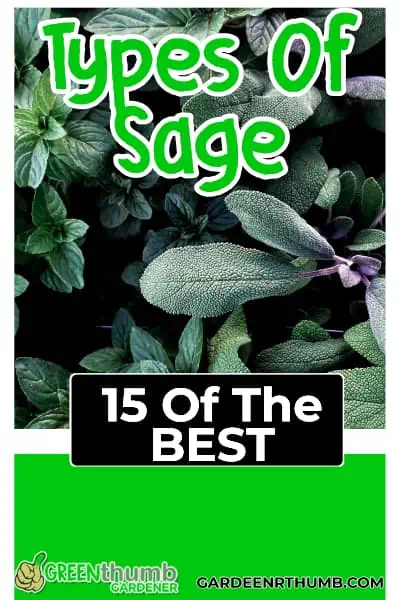
Pineapple sage is also an excellent aesthetic plant with tiny purple blooms and green foliage.
Sage that resembles a pineapple is a popular ingredient in the kitchen and can also be used as a tea and tincture.
This herb is commonly used for digestive relief, menstrual cramp pain reduction, anxiety relief, and a good night’s sleep.
3. White Sage (Salvia apiana)
The silvery-gray leaves of white sage are often used for “sage burning”. This species can be found in the southwestern United States and Mexico. It is frequently dried and ceremonially used as a smudge stick, which is then burned.
It prefers rich but well-drained soil and full sun and cooler climates.
Salvia apiana tends to have a burnt flavor that is stronger than other varieties.
White sage is exceptionally hardy and may be grown in zones five to nine.
It has a pungent, pine-like scent with a smokey finish that can also be used as a culinary herb, although its strong flavor may not be for everyone.
It is considered incredibly valuable for ceremonial purposes by many Native Americans. In addition, because of the distinctiveness of its white blossoms, it makes an excellent ornamental plant.
Instead of spikey flowers, this variety produces circular white flowers in clusters, similar to bunches.
The high levels of antioxidants in sage and anti-inflammatory properties make it beneficial for medicinal purposes such as warding off infection and maintaining good health.
It also has stimulating properties and is sometimes used to alleviate digestive difficulties.
Want to learn more about promoting sage growth? Check out this video below.
4. Mexican Bush Sage (Salvia leucantha)
This particular sage is thought to have come from Mexico or Central America. Between 2 and 3 feet tall, it has finely tinted leaves and dark green. This plant does well in direct sunlight, despite its preference for moist environments.
These plants prefer uniformly moist soil and put on a gorgeous display while they’re in bloom. Salvia leucantha is most known for its long, arching racemes of blooms.
They attract bees and hummingbirds, and butterflies because of their brilliant hues and white tips that fall into a tubular lavender calyx in the late summer.

This vibrant pink tricolor sage and unusual flower shape are frequently used as a decorative plant in gardens. Mexican bush sage is a good border plant when cultivated on steep hillsides and watered often.
Due to its capacity to grow in hot climates can also be used as a ground cover.
It can extend over large areas due to its rapid spreading capacity. It can also be used to brew tea, which can help prevent disease and infection because of its remarkable antioxidant and anti-inflammatory characteristics.
It’s also said to be a stimulant and can be used to treat various diseases, including digestive problems.
5. Woodland Sage (Salvia nemorosa)
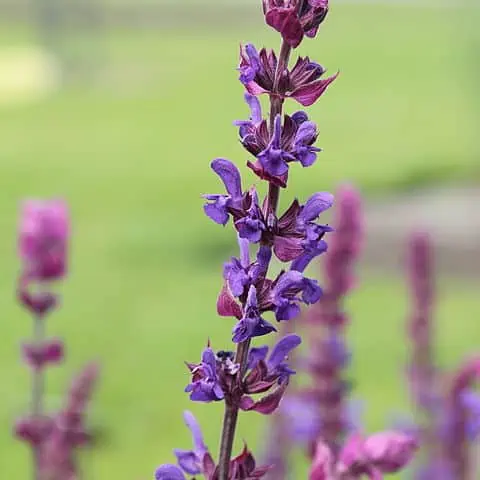
Woodland sage is a 3-foot tall perennial plant with green leaves with a purple pattern. Its flowers have a rich color with blue and pink cultivars. Summer cultivation is possible in USDA zones 4–8, and they are relatively drought tolerant.
The best way to grow wood sage is from seed, and don’t over water or fertilize. It can also be used as a border for open woodlands or mixed borders with taller plants. In addition, the fragrance of the blossoms can attract bees, butterflies, and birds.
Although wood sage grows through rhizomes, which are harmless, the plants grow on top of the earth. To save space, woodlands sage is typically grown in pots or raised beds. Despite being a drought-tolerant plant, it prefers moist well-draining soil.
Woodland sage is frequently employed in traditional medicine. It has been used to cure various ailments, including anxiety, upset stomachs, and vomiting.
In some cultures, the leaves are also used to make tea, which can be used to treat colds, coughs, and fevers.
6. Golden Sage (Salvia officinalis)
“Golden sage” is another name for Salvia officinalis common sage. It can grow up to 2 feet tall and spread almost twice its size when first planted. Irregular green patches appear in the middle of its creamy leaves, which vary on each leaf.
Once established, this sun-loving plant can tolerate dry soil.
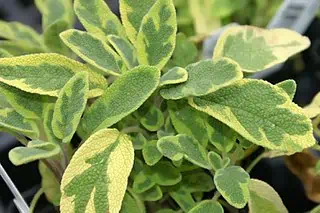
If you’re looking for a sage that is both aromatic and flavorful but also has beautiful variegated leaves, then golden sage is your best bet. Golden sage will thrive whether grown on the ground or in pots.
Any well-drained soil will do for this sage, and it only requires moderate average moisture. Although many people would grow Golden Sage for its decorative qualities, it is beneficial as a medicinal and culinary sage.
7. Anise-scented Sage (Salvia guaranitica)

Anise-scented sage is another common kind of sage. This aromatic sage disperses an anise-like scent, hence earning it the name.
Its deep-green leaves and purple-blue flowers make it one of the easiest plants to spot in gardens.
Salvia guaranitica, one of the most popular salvias, has beautiful spikes of large blooms with white, purple, or blue calyces that make it very appealing.
Perennial herb Salvia guarantica blooms in abundance from the middle of summer to the end of fall.
It requires evenly moist, well-drained soil but is a drought-tolerant plant, especially if you do regular watering during the day.
Its flowers and leaves are distinctive, and the plant can grow to be more than 6 feet tall.
8. Greek Sage (Salvia fruticosa)
Greek sage is an evergreen shrub that grows to a maximum width and 3.2 feet in height (1m). The bushy appearance of the plant is due to the profusion of large, flat leaves that grow in clusters.
It likes to live in warm climates similar to the Mediterranean region and grows better in humid environments than in dry ones.
Another name for Faskomilo tea is Faskomilo tea, which is readily available in supermarkets.
This aromatic herb is a popular choice for tea because of its minty aroma and flavor.
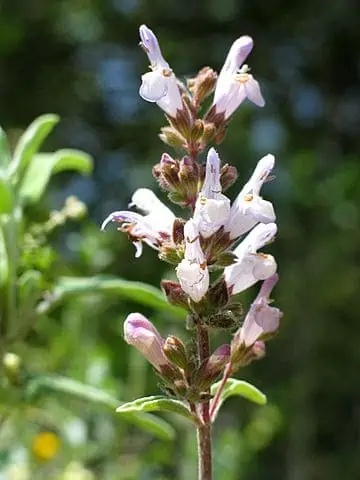
In addition, tea made from the plant’s leaves has medicinal purposes, including soothing sore throats.
9. South African Sage (Salvia lanceolata)
The South African sage has attractive grey-green foliage and produces light crimson to pink flowers. The South African sage, which is distinguished by its lemony flavor, is a widely desirable culinary ingredient.
This type of sage will have a strong minty scent that accompanies the slightly peppery flavor of the blend. It is also a tiny cultivar, with most plants growing no more than 2 feet in height.
It grows in humid settings, but it does well in any habitat.
It is particularly well adapted to seaside gardens and areas with sandy, rocky, or gravel soils.
10. Grape-Scented Sage (Salvia melissordora)
Known as grape-scented sage, Salvia melissodora is a woody perennial shrub that grows in altitudes ranging from 4,000 to 8,000 feet in the Sierra Madre Oriental mountain range in southern Mexico. It likes moist environments over dry ones.
It is drought-resilient; however, it performs best when watered at 10 days to 2 weeks intervals. It can grow around 4 feet tall and has some of the most woody stems you’ll find anywhere.
Because of its bush-like appearance, it stands out and has the potential to spread swiftly.
Hardy to temperatures of roughly 20 degrees, though a well-established plant or one planted against a wall or in a protected place will be able to recover from cold spells.

The leaves are frequently light green, and the blossoms are typically a deep grape hue. However, they can also be purple.
It can also be used as a decorative plant. The aroma of this sage is slightly grapey, as implied by its name, and it is simple to detect. As a result, it is widely consumed as a tea and in a variety of other culinary applications.
11. Cleveland Sage (Salvia clevelandii)
Blue sage and Jim sage are other names for this plant. Originally from the coasts of southern California and northern Baja California, Cleveland Sage is a gorgeous, fast-growing, and extremely scented variety of sage that grows abundantly in the area.
What sets it apart from other sage plant varieties is its size which can exceed 5 feet when the appropriate conditions are met.
It thrives in warm, humid settings with high relative humidity levels. Additionally, sandy soils with good drainage are preferred.
It has ash-green leaves with tiny ridged teeth around the edges that have a leathery texture and a wrinkled, leathery texture. It produces many spherical blue to pink flower clusters with lengthy filaments in a clumping fashion.
The fruit of this plant is a spotted nutlet, and hummingbirds are attracted to it in large numbers. This plant is one of the more popular ornamental sage plants and not one of the culinary sage types.
12. Purple Sage (Salvia dorrii)
Salvia dorrii are upright, perennial woody shrubs sometimes referred to as desert sage. They are extremely drought tolerant and like rocky or even sandy soil to other soil types.
They are best planted in the spring or early summer due to their rapid growth.
This plant’s magnificent deep blue flowers bloom in late spring and continue to bloom for most summer months.
Aside from that, they’re a fantastic alternative for hot climates where water conservation regulations apply.
This Drought-tolerant plant is hardy, easy to grow, and requires little upkeep. However, they require adequate drainage and dry climates.
Native Americans have long employed the extremely scented leaves, which have mild psychedelic qualities, in herbal medicine and tribal ceremonies for thousands of years, according to legend.
13. Autumn Sage (Salvia greggii)
Autumn sage (Salvia greggii) is a woody perennial indigenous to North America.
An excellent choice for cold climates, the autumn sage blooms brilliantly all year long, even in the coldest of climates, without wavering.
However, because of its drought tolerance and ability to withstand high temperatures and humidity, it grows in warm climates. Autumn sage thrives in moist, well-drained soils, where it can grow to a height of 2 to 3 feet.
Additionally, it produces pink-to-purple blooms, occasionally orange or red, on top of 2-inch minty-selling green oval leaves that are surrounded by a rosette of minty-selling green oval leaves.
Due to its high aesthetic value as an ornamental plant rather than for food purposes, you are more likely to discover it in gardens than in the wild.
However, its minty aromatic scent and flavor are also an excellent addition to any kitchen.

Further Reading
14. Hummingbird Sage (Salvia spathacea)
Hummingbird sage, sometimes known as pitcher sage, has dark green foliage and dark purple blooms. Its flowers on spikes can grow to be more than 4 feet tall in the right conditions.
It is also one of the easiest to cultivate, as it tolerates drought and partial shade.
The plant has scented arrow-shaped light green leaves that can grow up to 6 inches long and are wrinkled on top and hairy below.
It’s a hardy plant that may go dormant in the summer and then bounce back to life with regular irrigation in the fall and winter. It is resistant to disease and pest infestation.
Because of the distinctive color of the leaves and blooms, it is more of an ornamental plant than a culinary one.
15. Italian Sage (Salvia officinalis ‘Italian’)
It is sometimes known as Dalmatian Sage, and it is particularly well-known for its culinary applications.
Large violet blooms adorn this hardy evergreen shrub. The leaves are highly scented and beautifully veined.
Even though this kind of culinary sage is not typically used for medical purposes, it is an excellent choice if you want to plant it for ornamental purposes.
Up to 2 feet tall, it has opposite ovate leaves about 1 inch in length and grow on either side of the stem.
Final Thoughts
Sage plants are beneficial can be used either for culinary purposes, as an ornamental plant, or even as a floral arrangement. Small amounts of sage are often utilized because of its aromatic leaves and earthy flavor.
In addition, it has a lot of antioxidants, and sage extract can enhance cognitive performance, help maintain good oral health, and lower cholesterol and blood sugar levels.

